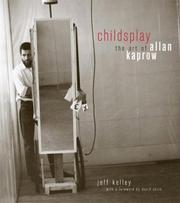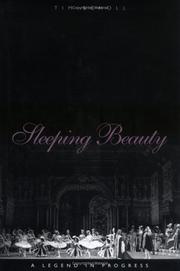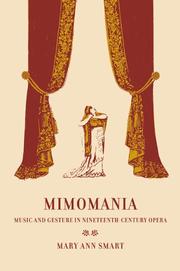| Listing 1 - 4 of 4 |
Sort by
|

ISBN: 0520236718 9780520236714 Year: 2004 Publisher: Berkeley, Calif. University of California Press
Abstract | Keywords | Export | Availability | Bookmark
 Loading...
Loading...Choose an application
- Reference Manager
- EndNote
- RefWorks (Direct export to RefWorks)
Allan Kaprow has been described as an avant-garde revolutionary, a radical sociologist, a Zen(ish) monk, a progressive educator, and an anti-art theorist. But, above all, as this book reminds us, he has been an influential artist. Known for his "Happenings," Kaprow created vanguard performances in the early 1960s in which he collaged various art forms (painting, music, dance), disguised as ordinary things (newspaper, noise, body movement), into quasi-theatrical events. In the decades since, his works have remained open to the changing character of contemporary experience, always seeking the thresholds at which art and life converge. Because this art places such emphasis on direct experience, some people today think Kaprow's works were primarily transitory and immaterial. 'Childsplay 'corrects that misconception by providing a vivid description of Kaprow's Happenings and other art activities, clarifying their materiality, duration, and setting, as well as the ways in which people participated in them. Jeff Kelley brings the artist, his era, and his work to life by showing that Kaprow's artworks were physically present, socially engaged, and intellectually resonant in the moment of their enactment.
Kaprow, Allan --- kunst --- twintigste eeuw --- installaties --- Kaprow Allan --- concept art --- conceptuele kunst --- happenings --- performances --- 7.071 KAPROW --- Conceptual art --- Happening (Art) --- Criticism and interpretation. --- Conceptual --- Action theater --- Event art --- Manifestations (Happenings) --- Mixed means, Theater of --- Painter's theater (Happenings) --- Realizations (Happenings) --- Theater of mixed means --- Total art (Happenings) --- Total theater (Happenings) --- Art, Modern --- Arts, Modern --- Pantomime --- Performance art

ISBN: 0300099568 9786611729165 1281729167 0300128827 9780300128826 9780300099560 9781281729163 Year: 2004 Publisher: New Haven : Yale University Press,
Abstract | Keywords | Export | Availability | Bookmark
 Loading...
Loading...Choose an application
- Reference Manager
- EndNote
- RefWorks (Direct export to RefWorks)
In 1999 the Maryinsky (formerly Kirov) Ballet and Theater in St. Petersburg re-created its 1890 production of Sleeping Beauty. The revival showed the classic work in its original sets and costumes and restored pantomime and choreography that had been eliminated over the past century. Nevertheless, the work proved unexpectedly controversial, with many Russian dance professionals and historians denouncing it. In order to understand how a historically informed performance could be ridiculed by those responsible for writing the history of Russian and Soviet ballet, Tim Scholl discusses the tradition, ideology, and popular legend that have shaped the development of Sleeping Beauty. In the process he provides a history of Russian and Soviet ballet during the twentieth century.A fascinating slice of cultural history, the book will appeal not only to dance historians but also to those interested in the arts and cultural policies of the Soviet and post-Soviet periods.
Ballet --- Dance --- Pantomime --- History. --- Sleeping beauty (Choreographic work) --- Sleeping princess (Choreographic work) --- Slapende skone (Choreographic work) --- Bella dormente (Choreographic work) --- Bella addormentata nel bosco (Choreographic work) --- Spi︠a︡shchai︠a︡ krasavit︠s︡a (Choreographic work) --- Spící krasavice (Choreographic work) --- Apburtā princese (Choreographic work) --- Törnrosa (Choreographic work) --- Belle au bois dormant (Choreographic work)

ISBN: 1282358545 9786612358548 0520939875 1597347531 9780520939875 0520239954 9780520239951 9781597347532 1417545348 9781417545346 9780520248311 0520248317 9781282358546 6612358548 Year: 2004 Publisher: Berkeley University of California Press
Abstract | Keywords | Export | Availability | Bookmark
 Loading...
Loading...Choose an application
- Reference Manager
- EndNote
- RefWorks (Direct export to RefWorks)
When Nietzsche dubbed Richard Wagner "the most enthusiastic mimomaniac" ever to exist, he was objecting to a hollowness he felt in the music, a crowding out of any true dramatic impulse by extravagant poses and constant nervous movements. Mary Ann Smart suspects that Nietzsche may have seen and heard more than he realized. In Mimomania she takes his accusation as an invitation to listen to Wagner's music-and that of several of his near-contemporaries-for the way it serves to intensify the visible and the enacted. As Smart demonstrates, this productive fusion of music and movement often arises when music forsakes the autonomy so prized by the Romantics to function mimetically, underlining the sighs of a Bellini heroine, for instance, or the authoritarian footsteps of a Verdi baritone. Mimomania tracks such effects through readings of operas by Auber, Bellini, Meyerbeer, Verdi, and Wagner. Listening for gestural music, we find resemblance in unexpected places: between the overwrought scenes of supplication in French melodrama of the 1820's and a cluster of late Verdi arias that end with the soprano falling to her knees, or between the mute heroine of Auber's La Muette de Portici and the solemn, almost theological pantomimic tableaux Wagner builds around characters such as Sieglinde or Kundry. Mimomania shows how attention to gesture suggests a new approach to the representation of gender in this repertoire, replacing aural analogies for voyeurism and objectification with a more specifically musical sense of how music can surround, propel, and animate the body on stage.
Gestes à l'opera. --- Opera --- Gesture in opera. --- Comic opera --- Lyric drama --- Opera, Comic --- Operas --- Drama --- Dramatic music --- Singspiel --- History and criticism --- 19th century. --- attention to gesture. --- auber. --- beauty. --- bellini. --- drama. --- famous composers. --- gestural music. --- live music. --- melodrama. --- meyerbeer. --- mimetic functions. --- mimomania. --- modern music. --- music and gesture. --- music criticism. --- music critics. --- music historians. --- music history. --- music studies. --- musical figures. --- musicians. --- musicology. --- nervous movements. --- nonfiction. --- opera composition. --- opera. --- pantomime. --- physical experiences. --- richard wagner. --- romantic period. --- verdi.
Book
ISBN: 9062834051 Year: 2004 Publisher: Bussum Coutinho
Abstract | Keywords | Export | Availability | Bookmark
 Loading...
Loading...Choose an application
- Reference Manager
- EndNote
- RefWorks (Direct export to RefWorks)
De kern van het boek bestaat uit drie uitgewerkte lessenseries voor de onder-, midden- en bovenbouw. Ze vormen samen een leerlijn. De leerlijn kent varianten voor beginnende, gevorderde, taalzwakke en NT2-leerlingen. De theorie staat geheel in dienst van de beschreven lessen en geeft antwoord op de vraag naar het waarom van alle keuzes die leerkrachten moeten maken. Door zelf dramalessen te geven en zich te verdiepen in het leerproces van de leerlingen en van zichzelf, verwerven (aankomende) leerkrachten de in het boek beschreven competenties voor dramatisch spel.
#KVHB:Dramatechnieken --- #KVHB:Expressie --- #KVHB:Lager onderwijs --- 477.2 --- basisonderwijs --- didactiek --- dramatische expressie --- Didactiek (Vakdidactiek) --- Drama --- Dramatische expressie(Dramatische vorming) --- Kleuteronderwijs --- Lager onderwijs --- Rollenspel --- Toneel --- Basisonderwijs --- Bewegen --- Bewegingsexpressie --- Didactiek --- Dramatische expressie --- Dramatische vorming --- Handboek/cursus --- Kleuteronderwijs (Voorschoolse educatie) --- Leerlijn --- Muziek --- Non-verbaal gedrag --- Pantomime --- Pop --- Scenario --- Schilderij --- Spel --- Taal --- Theater --- Verhalen --- basisonderwijs : drama (ler) --- dramatische expressie (ler) --- 373.3 --- Onderwijs --- 042762.jpg --- Dramatische vorming: didactiek lagere school --- didactiek basisonderwijs - dramatische expressie, spel en beweging, verbale expressie --- Didactics of the arts --- Didactics of Kindergarten --- Didactics of primary education --- toneelonderwijs --- Dramatische expressie ; basisonderwijs --- Muzische vorming
| Listing 1 - 4 of 4 |
Sort by
|

 Search
Search Feedback
Feedback About UniCat
About UniCat  Help
Help News
News